In part 1 of this series on the 1889 Union Church signature quilt, we learned about signature quilts in general, explored some of the unique characteristics of this specific quilt, and revealed the history of the Union Church. Part 2 looked at some of the Libertyville people and businesses represented by the signatures. In Part 3, we’ll see how the signatures can be tied to major Libertyville events of the late 19th century and early 20th Century.
THE RAILROAD COMES TO TOWN
In October 1878, a meeting of prominent residents was held at the hardware store of George Schanck to discuss bringing the train to Libertyville. The Chicago, Milwaukee & St. Paul Railroad had run a line from Chicago to Milwaukee in 1872 – but on the east side of the Des Plaines River. The closest stop to the village was Libertyville Junction (known today as Rondout). Bad roads and a scarcity of bridges made it difficult to get farm goods to the train and on to larger markets.
A committee of Colonel Erwin B. Messer, Dr. Samuel Galloway, and George Schanck was appointed to confer with the railroad company. A deal was struck. The railroad would equip the road and run one train a day into town, providing the people of Libertyville would grade the road, build a bridge, and provide land for the depot.
On May 31, 1880 the first train whistle sounded in Libertyville. The first freight was a carload of reapers for George Schanck, Vice President of the company that brought the railroad to Libertyville, and a carload of salt for George Anderson’s dry goods store.
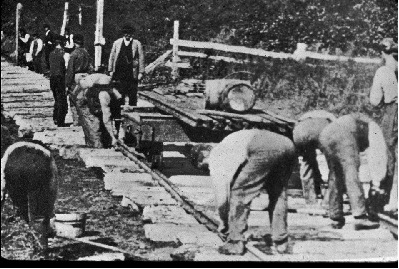 |
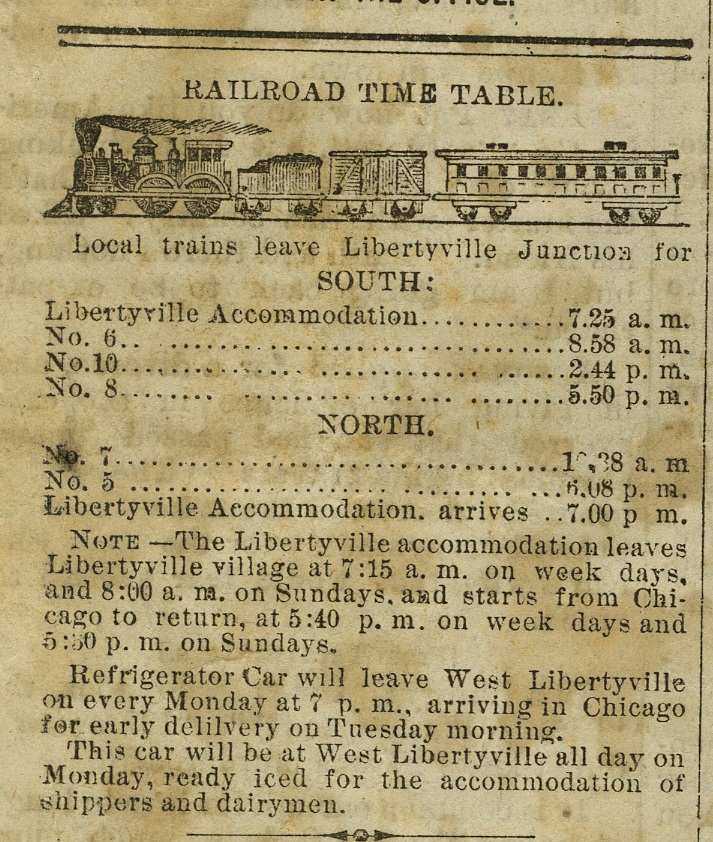 |
E.B. Messer (1838-1916), son of J.S. and Julia Messer, was a farmer and Civil War veteran. He served in Company F, 37th Illinois Infantry. Later he was commissioned Lieutenant Colonel of the 152nd Illinois Infantry. He was married to Eliza A. Howel and they had two children.
Samuel Galloway, M.D. (1828-1904), a prominent Libertyville physician, had his career outlined in detail in the 1891 Portrait and Biographical Album of Lake County Illinois having “3000 times administered chloroform without accident; out of 200 small pox cases he has saved all patients but six. He has attended 2000 obstetric cases very successfully. He has amputated 46 limbs, attended 900 cases of La Grippe [Spanish flu] and 3000 cases of cerebro spinal meningetis [sic].” The description also acknowledged that he “uses no spirits or tobacco, and is well preserved for one of his years and labors.”
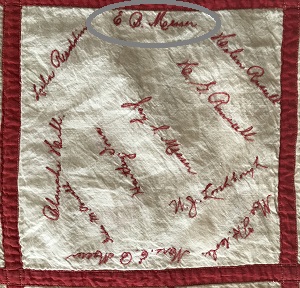 |
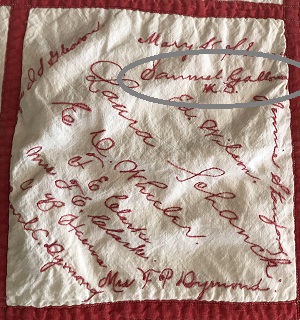 |
THE VILLAGE OF LIBERTYVILLE
The 1889 Union Church quilt was created at a time of significant change in Libertyville. Prior to the 1880s, Lake County was a county of rural farming communities, and Libertyville was no exception. The arrival of the railroad in 1880 brought with it a building and population boom. Two grain elevators, a hotel and livery stable, two lumber yards, several store buildings, and about twenty-five new homes were built between 1880 and 1882. The population of the village had doubled from 221 to 550 by 1890.
Encouraged by the increased development, leaders petitioned Judge Francis E. Clark in Waukegan for the right to hold a referendum on incorporation. The referendum was held on April 13, 1882, and a strong majority of Libertyville’s citizens voted to incorporate as a village. The first officers were elected a month later, and John Locke was elected as Libertyville’s first mayor.
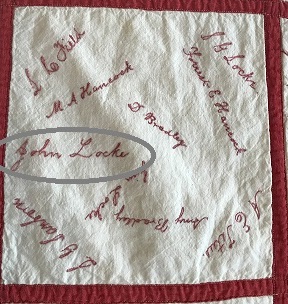 |
 |
John Locke (1811-1901) had come to Illinois from New Hampshire in 1836 making his way to Lake County in 1840 where he purchased the Charles Bartlett claim south of Libertyville. He moved to town in 1876. Locke served as mayor from May 15, 1882 to May 7, 1883. He was elected on the 6th ballot by the six village trustees. He also served as township supervisor in 1862, 1863, and 1881.
The names of several of Libertyville’s first mayors appear on the quilt: Josiah W. Butler, 1885 – 1886 (Square 24), Franklin P. Dymond, 1887 – 1889 (Square 22), Isbon S. Gleason, 1889 – 1890, 1891 – 1892 (Square 34) and Charles H. Averill, 1890 -1891, 1892 – 1898, 1899 – 1900 (Square 67).
1895 LIBERTYVILLE FIRE
In the hours between August 30 and 31, 1895, cigar maker Max LeBeau was awakened by the growl of his dog. His wife thought there might be a prowler. But instead Max discovered huge flames leaping skyward across the street at a business on the corner of Sprague Street [Cook Avenue] and Milwaukee Avenue. Bucket brigades quickly formed because there was no fire department. The Lake County Independent reported:
“Many ladies carried water and worked like horses while a few men hung idly on the fence at a safe distance, whose room was better than their company. We need not mention their names as they were marked and their lack of sympathy publicly noted. They will be remembered.”
Despite best efforts, and primarily because of a lack of readily available water, fighting the fire proved a losing battle. The fire spread burning over 20 frame buildings to the ground between Sprague Street [Cook Avenue] and High Street [School Street]. Buildings on the west side of Milwaukee Avenue went largely untouched. In the morning, there were just “heaps of burning, smoldering debris.”
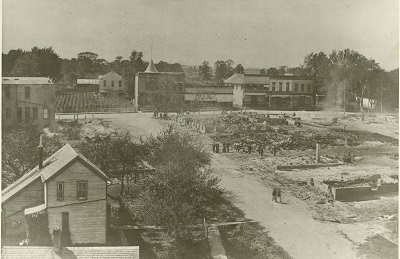 |
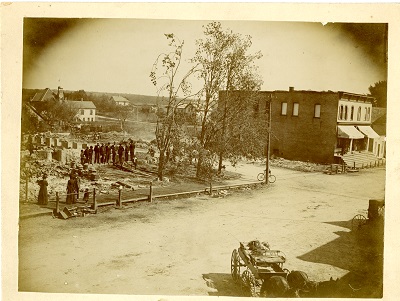 |
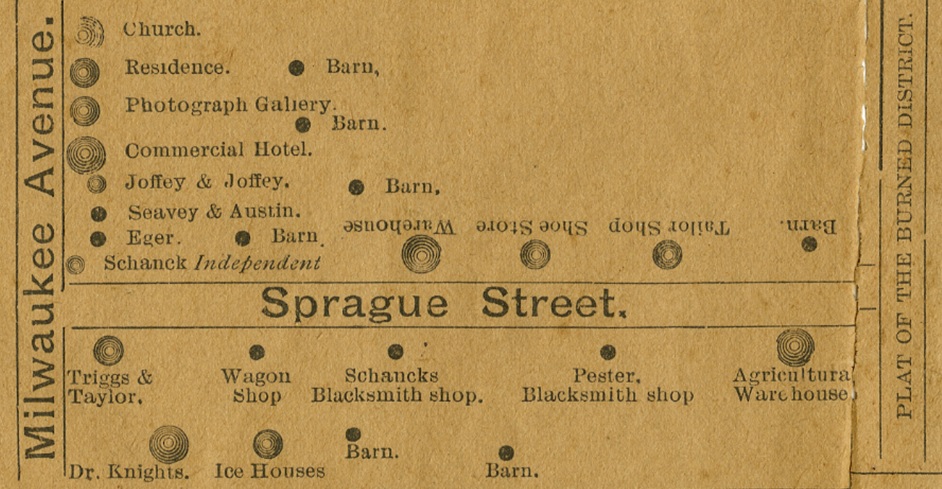 |
SCHANCK HARDWARE
Although the exact cause of the 1895 fire was never discovered, the flames were first spotted coming from the back of Schanck’s Hardware. George Schanck, born near Libertyville in 1837, started the hardware and farm implements business in 1870, and was one of the businesses to receive stock on first train to Libertyville.
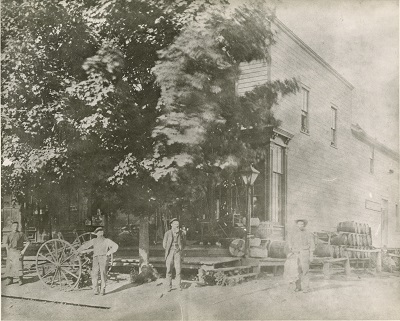
The fire destroyed not only Schanck’s hardware store, but several of his business concerns, including a grain elevator and a blacksmith’s shop.
His sons Gordon and Lewis took over the business in 1900 and ran it until the 1940s. It continued to operate as Schanck Hardware until the early 1960s when it was bought by the owner of the local Ace Hardware. Relocated to Peterson Road in 1965, the Ace Hardware is still in business today. Gordon Schanck, his sister, Laura Schanck, and their mother, Mary K. Schanck, represent the family on the quilt.
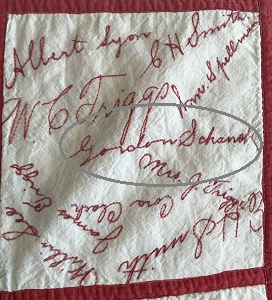 |
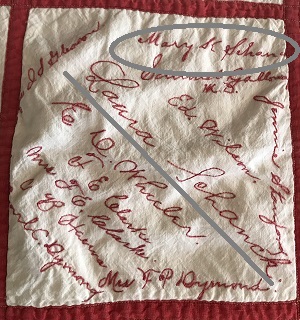 |
GROVE HOUSE HOTEL
One of the buildings lost to the fire was a nineteenth century Libertyville landmark, the Grove House. Built circa 1840s, the three story building boasted accommodations for up to 59 guests, a large dining room, and a third floor ballroom. Over the years it was known as the Grove House, Fisher House, Hotel Spoor, and finally the Commercial Hotel in 1895.

There is evidence that Eli P. Penniman ran the hotel for a time, starting in the 1850s. His son L. G. [Luther G.] Penniman and wife Mrs. A.E. [Amy E.] Penniman are on the quilt. W. C. Farnham is mentioned as proprietor in newspaper accounts of a New Year’s Eve party in 1868, and for another party advertised in the January 23, 1869 Waukegan Gazette.
An invitation to a “Social Party” for the evening of September 25, 1873, lists the hotel under the management of C. Fisher and G.A. Locke. By the 1880 census, C.P. Fisher is listed as a hotel keeper and his wife, Amelia (daughter of Eli Penniman), as landlady. The August 23, 1883 Libertyville Times confirms a name change to the Fisher House.
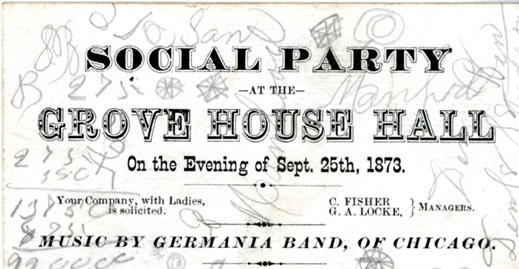 |
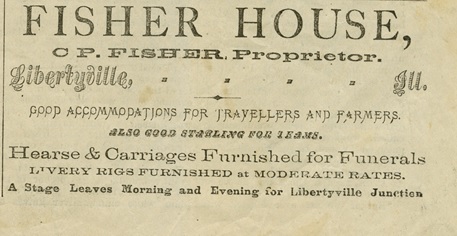 |
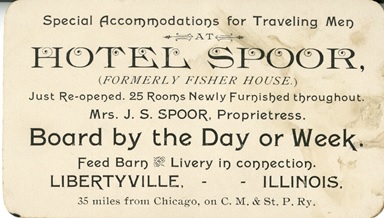
C.P. Fisher’s name is not on the quilt but his wife, Mrs. C.P. [Amelia Penniman] Fisher, and children, Crit [Christian], Garri [Garrison], and Zaidee, appear.
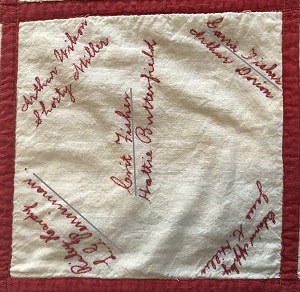 |
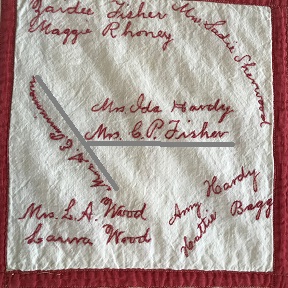 |
A NEW CENTURY – THE PROCTOR BUILDING
The 1895 fire caused much destruction and loss, but also cleared the way for building the downtown Libertyville recognized today. Commercial development within the village expanded rapidly at the beginning of the 20th century. From 1900 to 1910, eleven buildings were constructed within the central business district—nine along Milwaukee Avenue and two on Cook Avenue. The most important commercial building erected during the first decade of the twentieth century was the Proctor Block, financed by Proctor brothers, Robert, Charles, and Richard, with their cousin Elisha. Designed by Chicago architect William Krieg, the two-story brick building housed commercial storefronts and the New Castle Hotel, the largest of three operating hotels in Libertyville at the time. When it was completed in 1903, the block was lauded as “Libertyville’s first metropolitan building, the pride of all citizens…Towns five times the size of Libertyville cannot boast of buildings similar to the Proctor Block – and it can be said that such a building as the Proctor Block is just the kind of building Libertyville requires.”
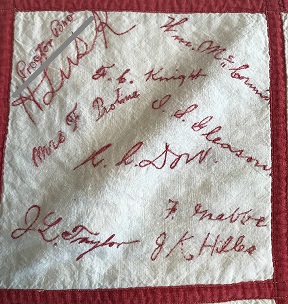 |
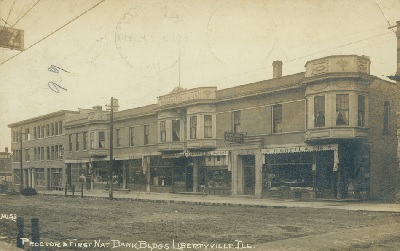 |
With over 680 signatures on the quilt, we have just scratched the surface of what we can learn about the people, businesses, and events in the Libertyville at the end of the 19th century. The research will continue!
All of the names can be viewed on the quilt key. If you recognize an incomplete name or have information about any of the names on the quilt, the Historical Society would love to hear from you. Please send an email to info@lmhistory.org.
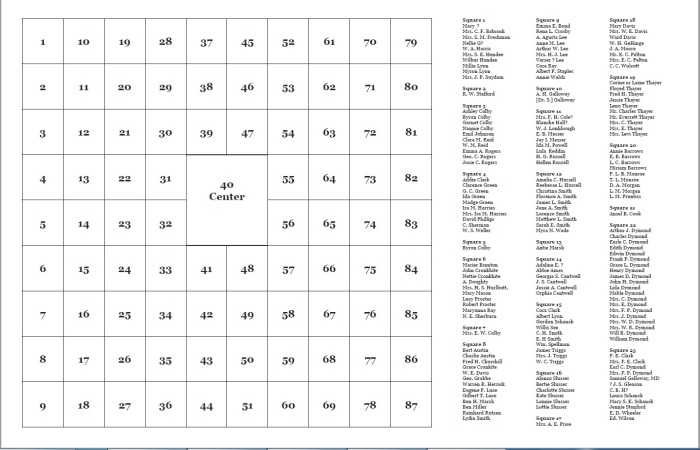
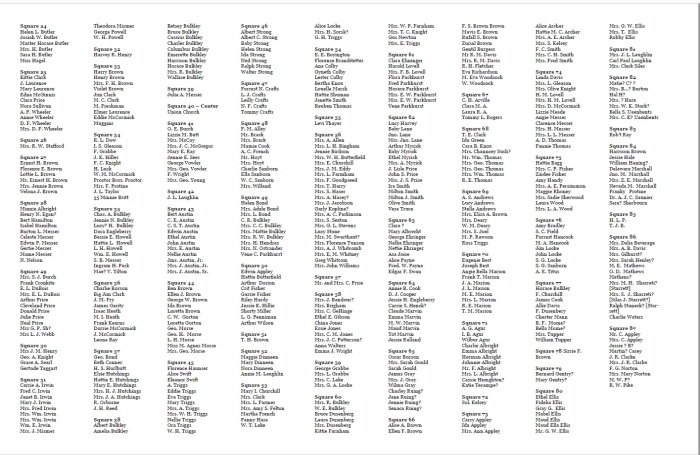
The Libertyville-Mundelein Historical Society would like to thank Marge Molitor, Suzi DeRose, Jenny Barry, and Heather Johnson for their work on this exhibit.
Sources:
- “The Story of a Palace in the Wilderness.” Independent Register, Feb 23, 1956.
- “Sudden and Sad Death.” Lake County Independent, March 11, 1910.
- “Death of Garrison A. Fisher.” Libertyville Independent, 16 Sep 1920, 1, p. 1
- “Early Resident Recalls Last Days of Old Hotel.” Independent Register, April 19, 1956, p.20.
- “Calico ball.” Chicago Tribune, February 19, 1875, p.8.
- “Sleighers.” Chicago Tribune, February 28, 1875, p.4.
- “Eli P. Penniman.” Portrait and biographical album of Lake County, Illinois. Chicago : Lake City Pub., 1891.
- “Party at Grove House.” Waukegan Gazette, January 23, 1869.”
- “New Year Party.” Waukegan Gazette, December 1868.
- “Twenty-five years ago in Libertyville.” Lake County Independent, April 24, 1908, p.4.
- “The ball…” Waukegan Gazette, February 21, 1880, p.2.
- “Samuel Galloway, M.D.” Portrait and biographical album of Lake County, Illinois. Chicago : Lake City Pub., 1891.
- “Destructive Fire at Libertyville: Dynamite is Used to Destroy Buildings and End the Flames.” Chicago Daily Tribune, 01 Sep 1895: 2
- 1873 Bird’s Eye View of Libertyville. Lithograph. Libertyville-Mundelein Historical Society collection.
- Lake County, Illinois map of 1861 : with landowners index / edited by Julie Weber & Aileen Potterton Hapke.
Imprint. Libertyville, Ill. : Lake County (IL) Genealogical Society, 1997. - 1880 U.S. Census. Libertyville, Illinois.
- “A.C. & C.P. Fisher” from “Our Businessmen.” Photocopied newspaper clippings from Anna Appley, 1882. Cook Memorial Public Library Local History File – Businesses.
- “A New Departure.” Inter Ocean, May 26, 1879, p.8.
- “J.S. Messer.” Portrait and biographical album of Lake County, Illinois. Chicago : Lake City Pub., 1891.
- “Samuel Galloway.” Portrait and biographical album of Lake County, Illinois. Chicago : Lake City Pub., 1891.
- “All is in Ruin.” Publication unknown. August 31, 1895.
- “Fire Edition.” Reprint of article from Lake County Independent, September 6, 1895 in the Independent Register, October 1979.
- “Burnt but Booming!” Lake County Independent, September 6, 1895.
- “Laid in Ashes.” Waukegan Weekly Gazette, September 7, 1895. p1.
- Libertyville Illustrated. Chicago : Kehm, Fietsch & Miller Co. Press, 1897.
- “Mrs. Mary Cater Schanck.” Lake County Independent, 3 Nov 1905, p. 5.
- “Geo. H. Schanck.” Lake County Independent, September 25, 1903.
- “Lewis Schanck, His Times and History.” Independent Register, February 2, 1956, p3.
- “Schanck is Midwife at County’s Birth.” Independent Register, February 9, 1956, p8.
- “Schanck Name Ends As Last Male Dies.” Independent Register, February 16, 1956, p9.
- “George H. Schanck.” from “Our Businessmen.” Photocopied newspaper clippings from Anna Appley, 1882. Cook Memorial Public Library Local History File – Businesses.
- “Gordon Schanck Rites are Held Wednesday; Died on Monday.” Independent Register, 28 Apr 1949, p. 1
- “John Locke.” Portrait and biographical album of Lake County, Illinois. Chicago : Lake City Pub., 1891.
- “Mr. John Locke died.” Lake County Independent, 8 Feb 1901, p. 4
- “Architectural Resources in the Downtown Survey Area, Libertyville, Illinois: Summary and Inventory. Ramsey Historic Consultants, 2016. http://www.libertyville.com/DocumentCenter/View/17179/Libertyville-2016-Survey-Report-FINAL-1?bidId=
- “Ace Hardware Town’s Oldest Retailer.” Independent Register, 2 Apr 1986, p. 12
Categories: Local History
Tags: Local History
